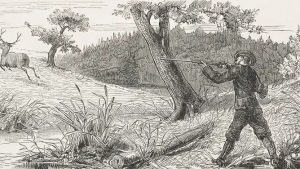
Is It Bad Luck to Shoot a White Deer? The Lackawaxen Stories
CHARMED WHITE DEER (New York Times – 1882)

De Agostini Editorial / Getty Images
Note: “Charmed White Deer” is the title of this article, although the “charmed” aspect didn’t work too well for a couple of the deer. It did, however, seem to work for the one that was unscathed after a hunter fired 12 shots at it. The text below is transcribed from the archived article (occasional typos from the original text were left in). The Shahola Hills (mentioned in the article) are south and southwest of Lackawaxen. The area is very beautiful, with many waterfalls–and there is, indeed, a White Deer Lake here.
Charmed White Deer
One of the peculiar superstitions of the hunters of Pike County is that the killing of a white deer will inevitably be followed by evil results to the one who fired the fatal shot. It is singular how deep the belief in this superstition is rooted, not only in the minds of the little educated backwoodsman, but among the residents of the highest intelligence. The Indian tribes that once inhabited the Delaware Valley believed that the white deer, which were very rare, were protected by a charm, and that their lives were sacred. There is a legend that a young Indian loved the daughter of his chief, and sought her as the Queen of his wigwam. The Indian maiden returned his love.
Her lover was one of the bravest of the brave, and the hero of many a battle. He was a leader among the young men of the tribe, and more popular than the chief. The latter was jealous of the warrior, and though hating him bitterly feared the consequences of having him removed from his path. The great love of the young brave for the daughter of the chief, was seized upon by the latter as a probable means of destroying his rival in the affections of the tribe. The chief gave his consent to the wedding of the pair, on one condition. This was, that the young warrior should bring to the wigwam of his chief, the dead body of a white deer as an offering. The lover, believing this to be a delicate, but emphatic rejection of his suit, returned without hope to his wigwam—for was it not as easy to pierce the hunter’s moon with an arrow, as to send a fatal shot within a white deer’s heart?
But, one day, the chief summoned the warrior to his presence. The sorcerer of the tribe, an aged Indian, to whom all the mysteries of nature were deemed by the tribe to be an open book, was with the chief. The sorcerer handed the young brave an arrow tipped with a silver head, and told him that if he was courageous enough to slay a white deer the silver arrow would break the charm and lay it dead at this feet. The warrior grasped the arrow, and declared that he was eager to show his love for the Indian maiden by firing the charmed arrow and offering the dead white deer at the wigwam of his chief.
High on the hills overlooking the valley of the Lackawaxen is a lake as clear as crystal. In the Indians days, as now, it was a fauvorite resort for deer. The young Indian launched his birch canoe on the waters of the lake, and anxiously awaiting the coming of deer at nightfall, hoping that amongst them there might be one of the charmed members of the herd. His hopes were realized, just as the last rays of the sun were glinting the surface of the lake, five deer stole from the woods and stood knee-deep in the cold water. Amongst them was a pure white deer. Quick as a lightning flash the silver-tipped arrow leaped from his bow. It gleamed for an instant in the air, and then sank into the white deer’s heart. With a cry that resounded far among the hills the white deer fell dead, and its companions fled in terror to the woods. While the death-cry of the white deer was echoing about the lake the young brave’s arms fell powerless to his sides. His tongue refused to give voice.
For days he drifted upon the lake. No succour came. He was powerless to end his sufferings by throwing himself in the lake. His dead and wasted body was found upright in the canoe by members of his tribe, after two “moons” passed. But other misfortunes followed the white deer’s death. At sunset on the day the young brave fired the fatal arrow, the chief was found dead in his wigwam. An arrow projected from his breast. It was taken from his heart. It’s tip was silver. The sorcerer was never seen again. The maiden, when her dead lover was found, leaped into the lake and found a grave beneath its waters. The tribe was never after able to cope with its enemies in battle, and was gradually destroyed. The !ake is known to this day as White Deer Lake.
The superstition as to the white deer, no doubt, was received from the Indians by the early white settlers of the valley, and has been preserved by these descendants. Among those who believe in the fatality that attends the killing of a white deer is the hon. William Westfall of Lackawaxen. He was formerly associate judge of Pike county, and is the present representative of the county in the Legislature.
Mr. Westfall disclaims being any way superstitious, but relates several instances that have come under his personal observation. He says he never knew of more than three white deer being in the vicinity of this place, and two of them were killed. White deer are always does. What freak of nature makes them white he does not know. The first white deer was killed in Lackawaxen many years ago by a hunter named James Van Gorden. The deer had roamed the ridges for years, and the superstition had protected her. She was often seen, and was “as white as the driven snow.” Van Gorden did not believe that so valuable a lot of venison should be allowed to waste, and, not sharing in the popular feeling for white deer, determined to bring her down. He hunted the deer season after season. He obtained many shots at her, but without effect. Then he made up his mind to try the charm alleged to be in the firing of a silver bullet. He moulded a bullet out of silver, and with his rifle loaded with it, started on the white deer’s trail. He came upon her as she was feeding, and sent the silver crashing into her heart. He killed the white deer, but, says Judge Westfall, it was his last shot. A wasting disease attacked him, and not long afterwards he died.
The second white deer remembered by Judge Westfall was killed by a hunter named Moses Brink. He was hunting in company with Alamanzor Griswold, a well-known resident of the valley, and a Commissioner of the county, and with Judge Westfall. Brink was heard to fire. The other hunters joined him. He said he had shot at a deer as it ran by him. The party walked on in the direction indicated, and a few steps away found a white deer dead. Brink declared it was not the deer he fired at, but it was evident that he must have done so. A few steps further on another deer of a grayish colour was found. It had been killed with the same bullet that had killed the white deer, being directly in range. The judge says that not one of the party was able to kill a deer afterwards, although each had been a successful hunter before. Brink, at that time, was one of the most hardy and healthy of men, but he died of consumption a few months afterwards, and Commissioner Griswold was subsequently killed by a load of stone falling upon him.
“The third white deer,” says the Judge, was never killed to my knowledge. I found the deer one morning on a favourite feeding ground, in company with a four pronged buck. She was as large as a two-year-old colt, and her ears were as long as a mule’s. The deer was not ten rods away, the buck being the nearer of the two, I aimed at the buck, but changed my mind and fired at the white one. She threw up her head, gave me a sorrowful look, and then went to eating the grass among the leaves. The buck, of course, was a mile away by this time. I fired a dozen shots at the beautiful creature, but not one had any effect, and I left the woods in disgust. The deer was well known to all the hunters along the Lackawaxen, and she finally disappeared. After my experience with her, I sold my favourite rifle, the companion of years, and purchased a more costly one. But luck was against me. I had scores of the finest shots a hunter could wish for, but I could never kill another deer. I gave my gun away, and have not been in the woods for years. I know I am not superstitious, but I would not fire a fatal shot at a white deer, for the entire gold fields of California.
The white deer which was proof against Judge Westfall’s bullets may have been the one which had no charm against the aim of Hornbeck, Shimer and his companions, Bevans and Frank, in 1872. Shimer was a native of the Lackawaxen Valley. He made a fortune during the war. He had, for some time been proprietor of, in the Exchange Hotel in Wilkesbarre, Pa., and was a well known politician and sportsman. In the above year, Lyman A. Bevans was a prosperous merchant of Port Jervis, N.Y. Henry Frank was a leading business man of the coal regions. In the fall of 1872 the three were camped in the mountains, a few miles back of Lackawaxen, deer hunting. They started a white deer, and all three succeeded in getting a shot at it and killed it. Ill luck attended every one of the party afterwards.
Shimer became an invalid, and died a miserable death two or three years afterwards. His affairs were badly involved, and his property dissipated. Henry Frank failed in business in 1875, and died of small-pox. Bevans became a bankrupt in 1878, and last fall committed suicide in an out house of his residence in Port Jervis by blowing his brains out. These misfortunes would have, no doubt, overtaken the men if they had not flown in the face of superstition, but it would be impossible to make the old-time Pike county hunter believe that they were not directly due to the killing of the white deer on the Shohola hills. Lackawaxen Penn., Corr. (correspondent?), New York Times.

